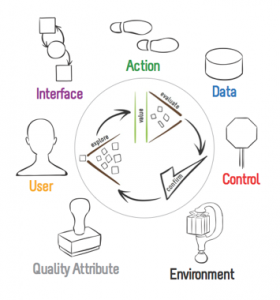„In small steps to the goal“ – a saying that can be transferred to all our life situations. You don‘t believe us? Then you definitely shouldn‘t miss the following blog post! We are pleased that our guest blogger and keynote speaker of the SOPHIST DAYS 2018 – Ellen Gottesdiener – gives you an insight into the concept of focusing effort on minimum viable product (MVP). You want to find out more and discuss with Ellen? Then join the SOPHIST DAYS 2018!
This blog was originally posted on the EBG Consulting blog.
Many product development teams talk about the wisdom of producing great products by iteratively exposing potential customers to small, cohesive product increments.1 The concept of focusing effort on minimum viable product (MVP) delivery has gained momentum particularly in the agile world. MVPs deliver customer value through successive delivery of small product slices and drives teams to make smarter choices about their product’s future development.

The Goldilocks Problem
Many teams suffer the Goldilocks problem when identifying their MVP. A MVP must be the right size (not too big and not too small) with just the right anticipated value (not too little and not too much).
Tomas Björkholm and I have written an article published on Infoq.com showing a powerful technique for achieving your MVP.2 In our experience, getting agreement to a shared understanding on a MVP is more difficult than you might think.
Why is a MVP Important?
The definition of a MVP can refer to different things including minimum marketable feature, minimum testable product, minimum valuable product, minimum feature set, or minimum buyable product. A MVP should consist of the smallest collection of backlog items that will bring value in customer satisfaction or validate a hypothesis.
In a nutshell, MVPs help teams deliver and validate faster.
Using Structured Conversations and the 7 Product Dimensions
To arrive at a MVP, product partners representing the customer, business and technology perspectives collaborate using a Structured Conversation. The Structured Conversation provides the framework that participants can explore, evaluate, and confirm product options using the 7 Product Dimensions.3

A robust Structured Conversation employs visualization. Each product dimension has a distinct image and color to enhance its semantic meaning. During their conversations, participants identify and value options for each of the 7 Product Dimensions, working with a Discovery Board. 4 To improve communication and understanding, the options and associated models are displayed on a wall as the team continues their discovery work.
Using Structured Conversations to explore, evaluate, and confirm future product options within and across the 7 Product Dimensions is a quick, consistent, and comprehensive approach to identity your next MVP. This approach exposes and reduces complexity by focusing on the simplest and most valuable options. Structured Conversations with the 7 Product Dimensions helps stakeholders engage, learn, and successfully deliver a valuable product.
Learn More
Many product and development teams struggle without an efficient way to define their MVPs and their corresponding sliced stories. In fact, Structured Conversation patterns have proven to be effective in a wide variety of industries.
In our InfoQ article, we highlight examples and much more detail that will enable you to get your MVPs just right. Click https://www.infoq.com/articles/structured-conversations-mvp and enjoy reading the article. And, as always, please let me know your thoughts.
Part 2: The Eyes Have It: How Visuals Can Energize Your Product Discovery
References
- Reis, Eric. The Lean Startup: How Today’s Entrepreneurs Use Continuous Innovation to Create Radically Successful Businesses. New York: Crown Business, 2011.
- Gottesdiener, Ellen and Tomas . “Using Structured Conversations to Discover Your MVP.” InfoQ (article). Mar 29, 2017. https://www.infoq.com/articles/structured-conversations-mvp
- Gottesdiener, Ellen and Jeff Sutherland. “Backlog Refinement Takes You from Vision to Value”. EBG Consulting (blog). September 9, 2017. https://www.ebgconsulting.com/blog/backlog-refinement-takes-you-from-vision-to-value
- Gottesdiener, Ellen. “Setting Up Your Discovery Board.” EBG Consulting, 2016. http://www.discovertodeliver.com/image/data/Resources/visuals/DiscoverToDeliver-Discovery_Board_Kit.pdf
About the Author
Ellen Gottesdiener is an Agile Product Coach and CEO of EBG Consulting,
focused on helping product and development communities create valuable
outcomes through product agility. Ellen is known in the agile community as an
instigator and innovator for collaborative practices for agile product discovery and
using skilled facilitation to enable healthy teamwork and strong organizations.
She is an author of three books on product discovery and requirements including,
with Mary Gorman Discover to Deliver: Agile Product Planning and Analysis, a
frequent speaker, and works with clients globally. In her spare time, she is
Producer of Boston’s Agile Product Open community and Director of Agile
Alliance’s Agile Product Management initiative. You can connect digitally via her
Blog | Twitter | Newsletter | LinkedIn
